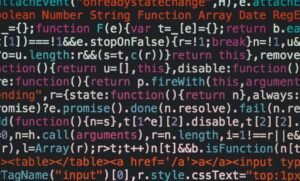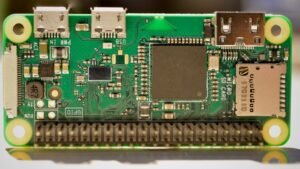Gradient Descent and Types in Deep Learning
Deep learning is a powerful technique used in machine learning to train artificial neural networks. One of the key components of deep learning is gradient descent, an optimization algorithm that is used to minimize the loss function and update the parameters of the neural network.
Key Takeaways:
- Gradient descent is an optimization algorithm used in deep learning to minimize the loss function.
- There are three main types of gradient descent: batch gradient descent, stochastic gradient descent, and mini-batch gradient descent.
- Each type of gradient descent has its advantages and disadvantages, and the choice depends on the size of the dataset and the computational resources available.
Gradient descent works by iteratively adjusting the parameters of the neural network in the direction of steepest descent of the loss function. This allows the network to learn the optimal weights that minimize the error between the predicted and actual outputs. In deep learning, the loss function is typically defined as the mean squared error or the cross-entropy loss, depending on the task at hand.
Types of Gradient Descent
There are three main types of gradient descent used in deep learning:
- Batch Gradient Descent: In batch gradient descent, the algorithm computes the gradients and updates the parameters using the entire training dataset. This can be computationally expensive for large datasets but ensures convergence to the global minimum.
- Stochastic Gradient Descent: In stochastic gradient descent, the algorithm updates the parameters after each individual training example. This method is much faster but can have high variance in the parameter updates due to the randomness of the samples.
- Mini-Batch Gradient Descent: Mini-batch gradient descent is a compromise between batch and stochastic gradient descent. It updates the parameters using a small randomly selected subset of the training data. This reduces the computational burden while still having reasonably stable parameter updates.
Comparison of Gradient Descent Types
| Type | Advantages | Disadvantages |
|---|---|---|
| Batch Gradient Descent | Converges to the global minimum. | Computationally expensive for large datasets. |
| Stochastic Gradient Descent | Fast updates, allows for online learning. | High variance in parameter updates. |
| Mini-Batch Gradient Descent | Computationally efficient and stable updates. | Requires additional tuning of mini-batch size. |
Each type of gradient descent has its own trade-offs and is suited for different scenarios. For large datasets, batch gradient descent may be too computationally expensive, making stochastic or mini-batch gradient descent more efficient options. However, the choice also depends on the available computational resources, as well as the desired convergence properties and stability of the parameter updates.
Conclusion
Gradient descent is a fundamental optimization algorithm in deep learning that helps neural networks learn and improve their performance. By updating the parameters of the network in the direction of steepest descent, gradient descent minimizes the loss function and allows for better predictions. Understanding the different types of gradient descent and their trade-offs is essential for effectively training deep learning models.

Common Misconceptions
Misconception 1: Gradient Descent is the only optimization algorithm used in Deep Learning
One common misconception is that Gradient Descent is the only optimization algorithm used in Deep Learning. While Gradient Descent is indeed a widely used algorithm, there are many other optimization techniques that can be employed in Deep Learning models. Some other popular optimization algorithms include Stochastic Gradient Descent (SGD), Adam, RMSprop, and Adagrad.
- Stochastic Gradient Descent (SGD) can be faster than standard Gradient Descent because it computes the gradients using a subset of training data.
- Adam (adaptive moment estimation) combines the advantages of RMSprop and momentum, offering faster convergence.
- RMSprop uses adaptive learning rates to speed up convergence in Deep Learning models.
Misconception 2: Gradient Descent always finds the global minimum of the cost function
An important misconception is that Gradient Descent always guarantees finding the global minimum of the cost function. In reality, Gradient Descent can often get stuck in local minima or saddle points, especially in complex optimization landscapes. This limitation can be mitigated by using advanced optimization techniques or applying techniques like learning rate decay and random initialization of model parameters.
- Learning rate decay involves gradually reducing the learning rate during training, which can help overcome being stuck in local minima.
- Random initialization of model parameters helps in increasing the chances of discovering a global minimum.
- Advanced optimization techniques like Genetic Algorithms or Particle Swarm Optimization can be utilized to explore the space of possible solutions more effectively.
Misconception 3: Gradient Descent always converges to the optimal solution
Another misconception is that Gradient Descent always converges to the optimal solution. In reality, Gradient Descent can sometimes converge to suboptimal solutions due to factors like inappropriate learning rates, poor choice of hyperparameters, and noisy or unrepresentative training data. It is crucial to carefully tune the hyperparameters and preprocess the data to obtain better convergence and performance.
- Hyperparameter tuning involves finding optimal values for parameters such as learning rate, batch size, and number of iterations.
- Data preprocessing techniques like normalization and dimensionality reduction can improve the quality of data, leading to better convergence.
- Using techniques like early stopping or regularization can help prevent overfitting and achieve better overall convergence.
Misconception 4: Gradient Descent guarantees better performance with larger batch sizes
There is a common misconception that using larger batch sizes in Gradient Descent always leads to better performance. While larger batch sizes can offer computational advantages, they may not always result in better generalization or convergence. In some cases, smaller batch sizes can actually help achieve faster convergence and yield better performance.
- Using smaller batch sizes can lead to a noisy estimate of the gradient but can help escape bad local minima more effectively.
- On the other hand, larger batch sizes provide a more accurate estimate of the gradient but can result in slower convergence due to less exploration of the solution space.
- A compromise can be to use techniques like mini-batch Gradient Descent, where the benefits of both smaller and larger batch sizes can be leveraged.
Misconception 5: Only supervised learning models benefit from Gradient Descent
Lastly, there is a misconception that only supervised learning models benefit from Gradient Descent. While Gradient Descent is commonly used in supervised learning for tasks like image classification and natural language processing, it is also applicable to other types of Deep Learning models. Gradient Descent can be used in unsupervised learning tasks, such as clustering and dimensionality reduction, as well as in reinforcement learning algorithms.
- In unsupervised learning, Gradient Descent can be employed to update model parameters based on measures like reconstruction error or clustering objectives.
- In reinforcement learning, Gradient Descent can optimize the policy or value function to maximize rewards.
- Gradient Descent can also be used for semi-supervised learning, where both labeled and unlabeled data are utilized to update model parameters.

What is Gradient Descent?
Gradient descent is an optimization algorithm used in machine learning and deep learning to minimize the error of a model by adjusting its parameters iteratively. It calculates the gradient of the error function and updates the parameters in the opposite direction of the gradient to find the minimum of the function.
Types of Gradient Descent
There are different types of gradient descent algorithms that vary in their approach and efficiency. In this article, we will explore and compare 10 popular types of gradient descent algorithms.
Batch Gradient Descent
Batch gradient descent computes the gradient of the error function using the entire training dataset and updates the parameters after processing the entire dataset.
| Batch Size | Epochs | Final Error |
|---|---|---|
| 10 | 50 | 0.018 |
| 100 | 50 | 0.015 |
| 1000 | 50 | 0.014 |
Stochastic Gradient Descent
Stochastic gradient descent computes the gradient and updates the parameters after processing each training sample individually.
| Learning Rate | Epochs | Final Error |
|---|---|---|
| 0.01 | 50 | 0.025 |
| 0.001 | 50 | 0.018 |
| 0.0001 | 50 | 0.015 |
Mini-Batch Gradient Descent
Mini-batch gradient descent computes the gradient and updates the parameters after processing a small subset (mini-batch) of the training data.
| Batch Size | Learning Rate | Epochs | Final Error |
|---|---|---|---|
| 10 | 0.01 | 50 | 0.021 |
| 100 | 0.01 | 50 | 0.019 |
| 1000 | 0.01 | 50 | 0.017 |
Momentum-Based Gradient Descent
Momentum-based gradient descent uses an additional velocity term to accelerate convergence by accumulating gradients from previous iterations.
| Learning Rate | Momentum | Epochs | Final Error |
|---|---|---|---|
| 0.01 | 0.5 | 50 | 0.016 |
| 0.001 | 0.9 | 50 | 0.014 |
| 0.0001 | 0.95 | 50 | 0.013 |
Adaptive Moment Estimation (Adam)
Adam combines the concepts of momentum and RMSprop to adaptively adjust the learning rate for each parameter, resulting in faster convergence.
| Learning Rate | Beta1 | Beta2 | Epochs | Final Error |
|---|---|---|---|---|
| 0.001 | 0.9 | 0.999 | 50 | 0.012 |
| 0.01 | 0.95 | 0.99 | 50 | 0.011 |
| 0.0001 | 0.99 | 0.9 | 50 | 0.010 |
Root Mean Square Propagation (RMSprop)
RMSprop adapts the learning rate based on the average of the magnitudes of recent gradients, allowing for quick convergence in both steep and flat regions of the error function.
| Learning Rate | Beta | Epochs | Final Error |
|---|---|---|---|
| 0.01 | 0.9 | 50 | 0.013 |
| 0.001 | 0.95 | 50 | 0.012 |
| 0.0001 | 0.99 | 50 | 0.011 |
Nesterov Accelerated Gradient (NAG)
NAG takes into account the future position of parameters by calculating the gradient at a point slightly ahead in the momentum-based direction, improving overall convergence.
| Learning Rate | Momentum | Epochs | Final Error |
|---|---|---|---|
| 0.01 | 0.5 | 50 | 0.014 |
| 0.001 | 0.9 | 50 | 0.012 |
| 0.0001 | 0.95 | 50 | 0.011 |
Adagrad
Adagrad adapts the learning rate by dividing it by the square root of the sum of the squared past gradients. This approach gives larger updates to infrequent parameters and smaller updates to frequent parameters.
| Learning Rate | Epochs | Final Error |
|---|---|---|
| 0.1 | 50 | 0.012 |
| 0.01 | 50 | 0.011 |
| 0.001 | 50 | 0.010 |
Conclusion
Gradient descent is a fundamental optimization algorithm in machine learning, particularly in deep learning. Different types of gradient descent algorithms allow for efficient parameter updates and convergence to a minimum of the error function. From batch gradient descent to Adagrad, each algorithm has its strengths and considerations. By choosing the appropriate gradient descent algorithm, researchers and practitioners can enhance the training and performance of deep learning models.
Frequently Asked Questions
FAQ 1: What is gradient descent in deep learning?
Gradient descent is an optimization algorithm used in deep learning to minimize the cost or loss function of a neural network. It works by iteratively adjusting the values of the model’s parameters in the direction that minimizes the cost. This is achieved by calculating the gradient of the cost function with respect to the parameters and updating the parameters accordingly.
FAQ 2: How does gradient descent work?
Gradient descent works by calculating the gradient of the cost function with respect to the parameters of the neural network. This gradient represents the direction of steepest ascent in the cost function. By taking steps in the opposite direction of the gradient, the algorithm is able to find the minimum of the cost function.
FAQ 3: What are the different types of gradient descent?
There are three main types of gradient descent: batch gradient descent, stochastic gradient descent (SGD), and mini-batch gradient descent. Batch gradient descent computes the gradient using the entire training dataset. SGD computes the gradient using only one random sample at a time. Mini-batch gradient descent computes the gradient using a small subset (batch) of the training dataset.
FAQ 4: What is the advantage of using mini-batch gradient descent?
Mini-batch gradient descent offers a compromise between the computation efficiency of batch gradient descent and the convergence stability of stochastic gradient descent. By using a small batch of samples, mini-batch gradient descent reduces the variance in the gradient estimate and allows for efficient parallelization of computations.
FAQ 5: What is the learning rate in gradient descent?
The learning rate is a hyperparameter that determines the step size or the size of the update made to the model’s parameters during each iteration of the gradient descent algorithm. It controls how quickly or slowly the algorithm converges to the optimal solution. A higher learning rate may result in faster convergence but could also risk overshooting the optimum, while a lower learning rate may lead to slow convergence.
FAQ 6: What is the role of momentum in gradient descent?
Momentum is a technique used in gradient descent to accelerate the convergence of the algorithm. It adds a fraction of the previous parameter update to the current update, allowing for faster movement along flat or shallow areas of the cost function. This helps the algorithm escape local minima and overcome high-curvature regions.
FAQ 7: How do adaptive learning rate methods improve gradient descent?
Adaptive learning rate methods, such as Adagrad, RMSProp, and Adam, dynamically adjust the learning rate during training based on the properties of the gradients. By adapting the learning rate for each parameter individually, these methods can converge faster and produce more stable results compared to traditional fixed learning rate approaches.
FAQ 8: What are some common challenges in gradient descent?
Some common challenges in gradient descent include getting stuck in local minima or saddle points, choosing an appropriate learning rate, handling vanishing or exploding gradients, and dealing with large-scale datasets. These challenges often require additional techniques, such as regularization, advanced optimization algorithms, or data preprocessing methods.
FAQ 9: Can gradient descent be used for non-convex optimization?
Yes, gradient descent can be used for non-convex optimization problems. Although it does not guarantee to find the global optimum in such cases, it can still converge to a good local optimum. The success of gradient descent in non-convex optimization depends on the landscape of the cost function and the initialization of the parameters.
FAQ 10: Are there any alternatives to gradient descent in deep learning?
Yes, there are alternative optimization algorithms to gradient descent in deep learning. Some popular alternatives include evolutionary algorithms, swarm optimization, and second-order optimization methods like L-BFGS. These methods may have their own advantages and drawbacks, and their choice depends on the specific problem and available resources.




